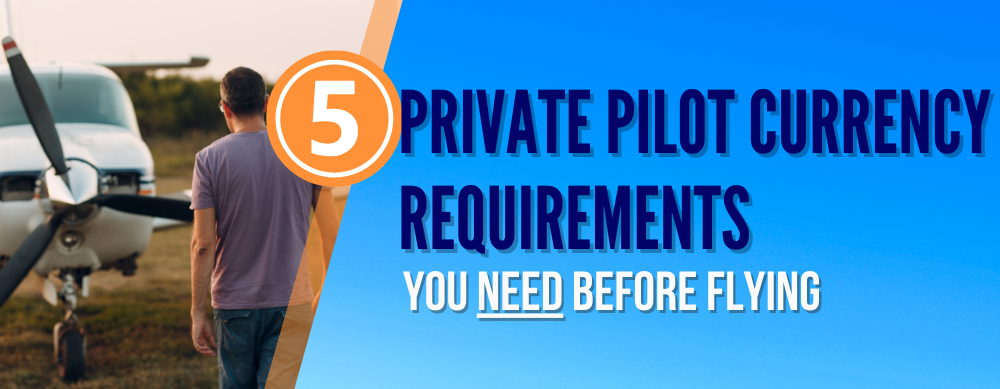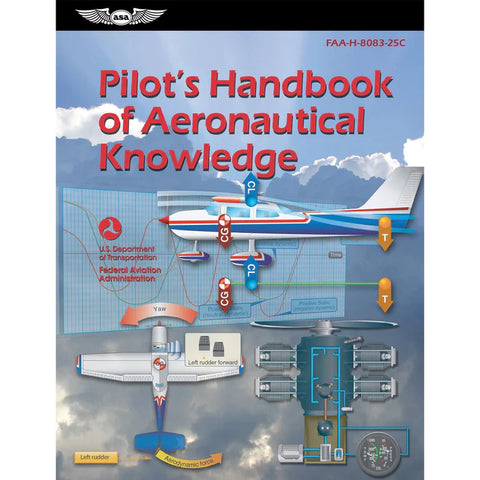5 Private Pilot Currency Requirements You Need Before Flying
Being a pilot is so much more than just steering a plane, it means that you are committed to safety, preparedness, and meeting the strict pilot currency requirements. You want to ensure that you're not just capable, but fully equipped to navigate the skies and provide a danger-free experience for those onboard.
Pull out your logbooks, because it's time to check if we're set to take on the responsibility of carrying passengers, and reignite the passion for flight.
Shall we begin?

Think about the exhilarating feeling of settling into the cockpit of an aircraft. The anticipation before takeoff, the sight of the world from the skies—it's an unmatched rush. But lately, life's kept you grounded, and now, with your family eyeing an upstate adventure in a rental aircraft, that familiar thrill calls to you once more.
As their excitement bubbles, you pause and realize that it's been a bit since you've flown. Your logbooks sit patiently, waiting to be revisited. It's time to flip through, reminiscing about past flights and pondering: Am I truly up to speed to confidently fly an aircraft carrying passengers?
Being a pilot is so much more than just steering a plane, it means that you are committed to safety, preparedness, and meeting the strict pilot currency requirements. You want to ensure that you're not just capable, but fully equipped to navigate the skies and provide a danger-free experience for those onboard.
Pull out your logbooks, because it's time to check if we're set to take on the responsibility of carrying passengers, and reignite the passion for flight.
Shall we begin?
 What Does it Mean to Be Current?
What Does it Mean to Be Current?
Maintaining currency as a private pilot involves meeting the Federal Aviation Regulations' 14 CFR 61.57 currency requirements, this is especially important for general aviation (GA) pilots. It's not just about logging hours.
These currency requirements encompass various aspects, from flight hours to specific tasks and maneuvers, ensuring that pilots keep up the skills necessary to handle different scenarios in the air.
 1. Day Currency Requirements (General Currency)
1. Day Currency Requirements (General Currency)
If you want to be able to fly and carry passengers at the same time, this is the currency you will need to keep up with.
General currency is a part of private pilot certificate currency reqs dictated by Federal Aviation Regulations. It requires that within the preceding 90 days, a pilot must have conducted at least three takeoffs and landings in the same category, class, and type of aircraft they intend to operate as the sole manipulator of the flight.
This applies to all aircraft, whether it's a standard configuration or a tailwheel airplane, mandating three full-stop takeoffs and landings specifically for tailwheel aircraft.
This currency shows that a pilot's skills using the flight controls--especially during a daytime takeoff and landing--remain recent, qualifying them to assume the role of a pilot in command and carry passengers.

TIP: It's important to keep in mind that while maintaining general flight currency helps meet FAA requirements, a pilot might want to check and ask themselves if they feel proficient enough to fly, seeing as these are two different things.
 2. Night Currency Requirements
2. Night Currency Requirements
Meeting general currency requirements does not mean you can fly with passengers at night. The FAA defines night as the period from the end of evening civil twilight to the beginning of morning civil twilight (14 CFR §1.1). However, for currency requirements under 14 CFR §61.57(b), the FAA specifically requires that takeoffs and landings for night currency be conducted between 1 hour after sunset and 1 hour before sunrise.
To carry passengers during this time period, pilots have to meet specific night currency requirements. These include three takeoffs and landings to a full stop during the night, within the last 90 days, and within one hour after official sunset to remain current for night flights.
The flights must be in an aircraft of the same category, class, and type of the aircraft you intend to fly with passengers in.
 3. Flight Review
3. Flight Review
Every 24 calendar months a pilot will need to take a flight review before they can act as pilot-in-command of an aircraft. Private pilots will need to write down and keep track of when they need to retake their flight review to maintain currency and proficiency.
What is a flight review?
The flight review is typically conducted by a flight instructor and is a comprehensive evaluation that makes sure that pilots are held to the standards set by the FAA's practical test standards.
The review is made of multiple parts, such as ground instruction and flight tests, covering essential areas like emergency procedures and slow flight. Think of it as a light version of the practical test the pilot had to take to get their license.
If a pilot does not do well in the review or appears to have forgotten anything, they can receive training until they meet the standards.
A flight review can also build confidence and allow the pilot to seek guidance, and knowledge from a seasoned instructor on any updated rules or regulations they might not have been aware of.
 4. Medical Currency
4. Medical Currency
It's important for a pilot to know what class of medical they need and to keep up-to-date with their medical certificate currency based on what their aviation goals are.
For example, if you are a student pilot, you will only need a 3rd class medical, but if you intend to go into the airlines, it might be a good idea to find out if you can pass a 1st class medical before spending the time and finances on training to find out that you do not qualify for the 1st class.
-
Class 1 Medical: The most restrictive medical certificate. Required for Airline Pilots (ATP). Must renew every 12 months, 6 months for those over 40 years old.
-
Class 2 Medical: Moderately restrictive. They are required for Commercial Pilots (CPL). Must renew every 12 months, cannot fly for transportation airlines.
-
Class 3 Medical: The least restrictive medical certificate. Required for Private Pilots (PPL). Must renew every 5 years if you are under 40 years old, and every 24 months if over 40 years old. Can only fly recreationally.
-
BasicMed: For private pilots using their personal plane for traveling. Can only have 5 passengers. Cannot fly an aircraft that weighs more than 6,000 lbs. Can only fly recreationally.
 5. Instrument Currency
5. Instrument Currency
Instrument rating currency is within the spectrum of private pilot currency reqs, applicable solely to pilots holding an instrument rating and navigating by instrument flight rules (IFR).
The currency is maintained through an instrument proficiency check, ensuring pilots have remained adept in handling instrument approaches and maneuvers.
For an instrument-rated pilot, staying current involves meeting specific requirements, such as holding, using interception, and tracking courses.
These are accomplished through flight instruction and the use of a view-limiting device(such as a hood or foggles) to simulate instrument meteorological weather conditions.
6HITS for IFR Currency
There is an acronym used in aviation to remind IFR pilots of how to stay current called "6HITS".
Within the 6 calendar months preceding the month of the flight:
-
6 - 6 instrument approaches
-
H - Holding procedures
-
I - Intercepting courses
-
T - Tracking courses
-
S - use of navigational electronic Systems
Not Current within 6 Months
If an IFR pilot is not current within 6 months, they can log time and renew their instrument currency by flying in simulated weather conditions with a safety pilot(who must also hold a private pilot license) or in actual weather conditions (IMC) with a certified flight instructor. Flying with an FAA examiner is also an option, but a pricey one.
Not Current within 12 Months
If an IFR pilot is not current within 12 months, they cannot renew currency with a safety pilot, they will require an instrument proficiency check (IPC) with a certified CFII or FAA examiner.
Using a Flight Simulator
If a pilot needs to maintain their instrument experience, they can use a full flight simulator, flight training device, or aviation training device. This is allowed under 14 CFR 61.57 as long as the device represents the type of aircraft for the rating and the pilot practices tasks in simulated conditions.
The pilot can mix and match between using an actual aircraft, full flight simulator, flight training device, or aviation training device to fulfill the requirement.
Other Currencies
For Certified Flight Instructors, their certificate is valid for 24 months. After that time they'll need to follow the renewal process that is outlined in 14 CFR 61.197.

|
ASA Pilot's Handbook of Aeronautical KnowledgeProviding basic knowledge essential for all pilots, from beginning students through to the advanced certificates, this Federal Aviation Administration (FAA) publication introduces readers to the broad spectrum of knowledge required as they progress through pilot training. Studying this book, pilots gain the required knowledge to earn a certificate and understand aerodynamic theory associated with flight. |
Takeaway
Sticking to the currency requirements is about more than simply meeting regulatory standards; it's about building proficiency and confidence to know that you can handle all scenarios safely and effectively. This is especially true for those with a commercial pilot certificate.
Keeping up with practicing performance maneuvers can help hone your skills as a pilot, and open the door to more opportunities.
As pilots, we are constantly improving our skills and techniques by embracing currency requirements. This leads to a stronger culture of proficiency and dependability, as we prioritize safety and comfort when we carry passengers in the skies.
Wishing you many happy flights ahead!
Want to learn more about pilot license requirements?
Our guides are designed to help student pilots become professional pilots and for private pilots to brush up on their knowledge and skills.
-
7 Types of Pilot Licenses: Learn Their Differences & Requirements
-
Sport Pilot License: Step-by-Step Guide to Becoming a Sport Pilot
Did you find this article helpful?
Do you think we missed anything important about staying current? Let us know in the comments below so we can fix that!

























2 comments
The FAA has published new regulations (effective Dec 2nd, 2024) for passenger currency for instructors and students on training flights. Learn about the upcoming regulatory changes, including a new ‘passenger’ definition, a new exception for flight training and how SFAR 73 affects those passenger requirements in an R22 or R44 helicopter in this short video: https://youtu.be/cPKi2TeeFKg
The night currency states “within one hour after official sunset.” That’s when night starts. So the landings must be “at least one hour after official sunset.”